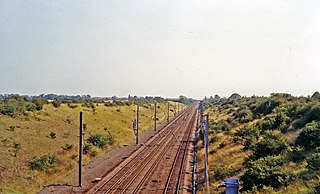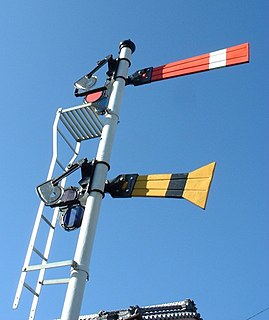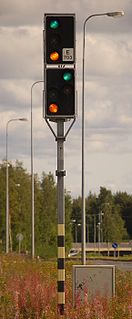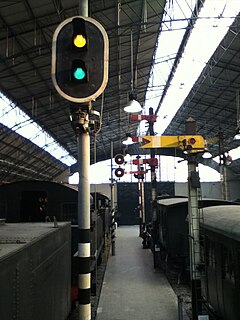
A railway signal is a visual display device that conveys instructions or provides advance warning of instructions regarding the driver’s authority to proceed. The driver interprets the signal's indication and acts accordingly. Typically, a signal might inform the driver of the speed at which the train may safely proceed or it may instruct the driver to stop.

Railway signalling is a system used to direct railway traffic and keep trains clear of each other at all times. Trains move on fixed rails, making them uniquely susceptible to collision. This susceptibility is exacerbated by the enormous weight and inertia of a train, which makes it difficult to quickly stop when encountering an obstacle. In the UK, the Regulation of Railways Act 1889 introduced a series of requirements on matters such as the implementation of interlocked block signalling and other safety measures as a direct result of the Armagh rail disaster in that year.
The signalling system used on the rail transport in Norway is regulated by the Regulations of December 4, 2001 no. 1336 about signals and signs on the state's railway network and connected private tracks.

The Automatic Warning System (AWS) was introduced in 1956 in the United Kingdom to provide a train driver with an audible warning and visual reminder that they were approaching a distant signal at caution. Its operation was later extended to give warnings for;

The railway signalling system used across the majority of the United Kingdom rail network uses lineside signals to control the movement of trains.
Australian railway signalling varies between the states of Australia as each railway was established under the different colonial governments with separate legislation. As with the notorious situation of having different gauges, there are differing signal systems. New South Wales signalling systems generally follow British precepts, however American influence has increased somewhat since the 1990s. The Victorian Railways use Speed Signalling. This can cause confusion where the systems meet. For example, in New South Wales, Green-over-Red means 'Caution', indicating the next signal is at 'Stop'. In Victoria that same aspect, Green-over-Red, means 'Clear Normal Speed', indicating the next signal is anything but at 'Stop'. On the main south line from Sydney, Single Light Colour Light signals are now exclusively used from Spring Creek bridge to Albury on the Victorian border. This forms a buffer zone between the areas giving conflicting signal indications. Gradually the remaining Upper Quadrant signals are being replaced by Single Light Colour Light signals.
Railway signals in Germany are regulated by the Eisenbahn-Signalordnung. There are several signalling systems in use:
The Toronto subway uses a variety of signalling systems on its lines, consisting of a combination of fixed block signalling and moving block signalling technologies.
The signalling system used on the standard-gauge railway network in Sweden is based on that of the traditional mechanical semaphore signals. Currently only colour-light signals are used, together with the Automatic Train Control system.

The Abbots Ripton rail disaster occurred on 21 January 1876 at Abbots Ripton, then in the county of Huntingdonshire, England, on the Great Northern Railway main line, previously thought to be exemplary for railway safety. In the accident, the Special Scotch Express train from Edinburgh to London was involved in a collision, during a blizzard, with a coal train. An express travelling in the other direction then ran into the wreckage. The initial accident was caused by:
The Canadian Rail Operating Rules (CROR) is a set of operating rules for railways in Canada. The CROR is used by every Canadian railway.

North American railroad signals generally fall into the category of multi-headed electrically lit units displaying speed-based or weak route signaling. Signals may be of the searchlight, color light, position light, or color position light types, each displaying a variety of aspects which inform the locomotive engineer of track conditions so that he or she may keep their train under control and able to stop short of any obstruction or dangerous condition.

Semaphore is one of the earliest forms of fixed railway signals. These signals display their different indications to train drivers by changing the angle of inclination of a pivoted 'arm'. Semaphore signals were patented in the early 1840s by Joseph James Stevens, and soon became the most widely used form of mechanical signal. Designs have altered over the intervening years, and colour light signals have replaced semaphore signals in most countries, but in few they remain in use.

Japanese railway signals, according to the ministerial decree defining technical standards of railways, are defined as indicating operational conditions for railway staff driving trains.
The Bavarian Group Administration or Gruppenverwaltung Bayern was a largely autonomous railway administration within the Deutsche Reichsbahn between the two world wars. It was formed on 1 April 1920 from the former Bavarian State Railways, and was unique, Bavaria being the only former German state to have such status after the merger of the seven state railway companiess into the Reichsbahn. The rest of Germany was simply divided into various regional Reichsbahn railway divisions.

The signalling system used on the railway network in Finland comprises color-light signals and fixed signs, used together with the Automatic Train Control system ATP-VR/RHK.
Swiss railway signalling describes the railway signalling systems used in Switzerland by the different railway companies. There are two main types of signal, used up to 160 km/h, above which speed cab signalling is required.

The Italian railway signalling currently in use, employed on the Italian national railway network, is regulated by the "Regulation on signals", issued by the Italian railway infrastructure manager, RFI.
The first railway signalling in Greece was installed on the Athens–Piraeus Railway at the turn of the 20th Century, when semaphores and boards were added with the line’s electrification. Other Greek trains at that time were controlled by signals given manually by station masters. During World War II, German occupation forces installed mechanically-operated semaphore signals at the entrance to all stations, with some light signals at busy stations. Modern signalling is provided through colour light signals. Radio communication between train stations and drivers was introduced in 1973 and digital communication is an ongoing present-day introduction.

The application of railway signals on a rail layout is determined by various factors, principally the location of points of potential conflict, as well as the speed and frequency of trains and the movements they require to make.















